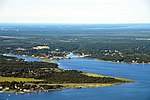Mastic station
1882 establishments in New York (state)Demolished railway stations in the United StatesFormer Long Island Rail Road stations in Suffolk County, New YorkNew York (state) railway station stubsRailway stations in the United States closed in 1960 ... and 1 more
Railway stations in the United States opened in 1882

Mastic was a station stop along the Montauk Branch of the Long Island Rail Road. It was located on the corner of Mastic Road and Mastic Boulevard at the Mastic Road grade crossing, near the Fire Department and Mastic Seafoods.
Excerpt from the Wikipedia article Mastic station (License: CC BY-SA 3.0, Authors, Images).Mastic station
Mastic Boulevard,
Geographical coordinates (GPS) Address Nearby Places Show on map
Geographical coordinates (GPS)
| Latitude | Longitude |
|---|---|
| N 40.8018951 ° | E -72.8396715 ° |
Address
Mastic Boulevard 163
11950
New York, United States
Open on Google Maps








